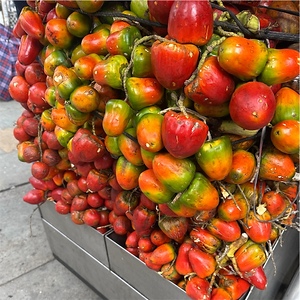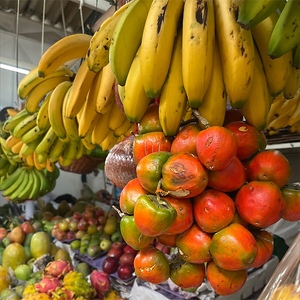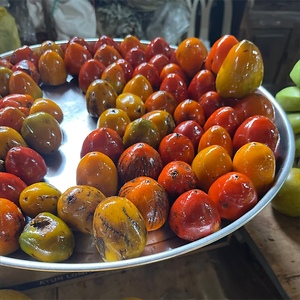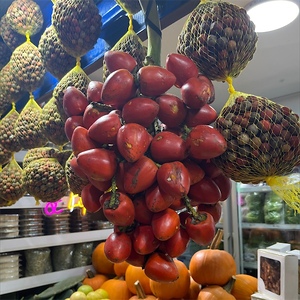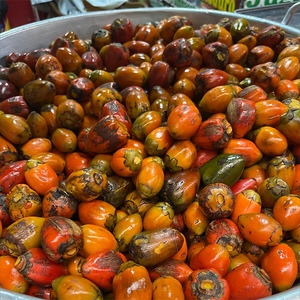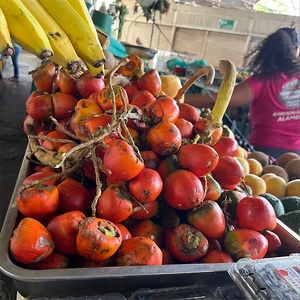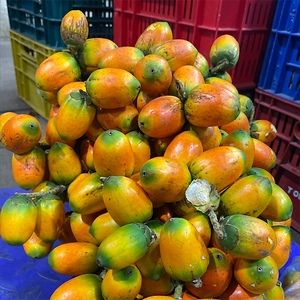

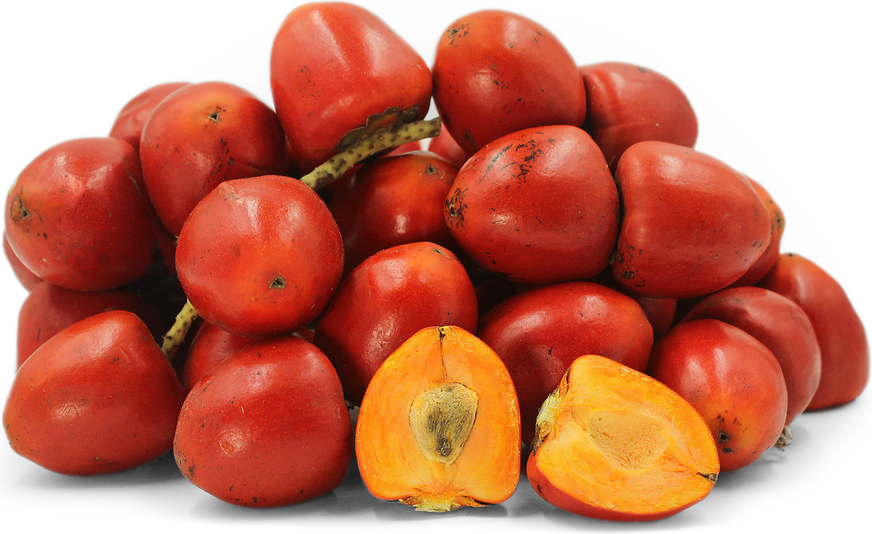
Chontaduro
Estimated Inventory, lb : 0
Description/Taste
Chontaduros are small drupes, averaging 3 to 5 centimeters in diameter and 4 to 6 centimeters in length, and have an ovoid, conical, to heart shape. The fruits grow in large bunches of 80 to 100 drupes, and there are many different varieties with varying skin tones ranging from orange, red, yellow, to green. The skin is smooth, thin, slightly wrinkled, and greasy. Underneath the surface, the flesh has a dense and starchy consistency with a dry and fibrous texture when raw, encasing a small, brown seed. Chontaduros are edible raw or cooked. After heating, the flesh softens to a consistency similar to a squash or sweet potato and has a neutral, subtly nutty flavor with notes of peaches.
Seasons/Availability
Chontaduros are available year-round, with a peak season in the winter through early summer in Central and South America.
Current Facts
Chontaduros, botanically classified as Bactris gasipaes, are colorful drupes that grow on palm trees belonging to the Arecaceae family. It is believed that there are over fifty varieties of Chontaduros found throughout tropical regions of Central and South America, and the fruits are known by two hundred regional names, including Peach Palm fruit, Pejibaye, Pupunha, Acana, and Pifa. Chontaduros have been an important food source for the people of the Amazonian jungle for over two thousand years. In the modern-day, the fruits are widely sold through local street vendors as an energy-boosting, nutritional snack. Chontaduros are highly valued for their neutral flavor, used in both sweet and savory culinary applications, and many cultures within South America, especially in Colombia, believe the fruit has natural aphrodisiac properties.
Nutritional Value
Chontaduros are a good source of fiber, which can stimulate the digestive system and provide some vitamins A, C, and E, which are antioxidants that can help protect the immune system against external environmental aggressors. The fruits also contain minerals, including magnesium, phosphorus, zinc, copper, iron, and calcium.
Applications
Chontaduros can be eaten raw or cooked and are popularly sprinkled with salt. The fleshy fruits are typically boiled in salt water, and once cooked, the skin is peeled, and the seed is removed. The cooked seed is also edible and has a flavor reminiscent of coconut. In South America, Chontaduros are commonly boiled and sold through street vendors, coated in salt, condensed milk, vinegar, lemon juice, or honey as an additional flavoring. The cooked fruits are also traditionally served with coffee. Beyond consumption as a boiled snack, Chontaduros can be prepared and pureed into sauces, soups, and stews, fried into chips, simmered into jellies and jams, pickled for extended use, or roasted and served with meats. The flesh can also be ground and processed into a flour that is used for bread, tortillas, pastries, and sauces. Chontaduros pair well with mayonnaise, sour cream, red wine, vanilla, coconut milk, sugar, meats such as poultry, beef, and pork, seafood, sweet peppers, onions, garlic, ginger, celery, and tomatoes. The fresh fruits will keep 3 to 7 days when stored in a cool and dry place such as the refrigerator.
Ethnic/Cultural Info
The Fiesta del Chontaduro is an annual event that celebrates the jungle fruit harvest while honoring the food that the Earth has provided. Traditionally run by the Cofan people, an ancient indigenous community within the tropical forests of Ecuador and Colombia, the three-day festival is located in Putumayo, Colombia, and has been held since the Middle Ages. During the festivities, Chontaduros are displayed in large piles and are also used as hanging decorations to line doorways, dance floors, and tables. The fruits are highly regarded within Colombian culture as a symbol of fertility, and throughout the festival, the fruits are honored through storytelling, beverages, loud instruments, and dancing. The Fiesta del Chontaduro also celebrates the fruit by hosting educational talks, craft shows, a parade, and even a pageant to select the next National Queen of The Chontaduro.
Geography/History
Chontaduros are native to tropical forests throughout Central and South America and have been growing wild since ancient times. There are many different wild and domesticated varieties of the fruit, and while the exact date of when commercial cultivation began is unknown, the fruits are widely sold at local markets across the neotropics. Today Chontaduros are grown commercially and are exported from Costa Rica and Brazil to other regions of the world, including Europe and Asia. The fruits are also found on a local level in fresh markets throughout Ecuador, Colombia, Brazil, Venezuela, Bolivia, Peru, Panama, and Costa Rica.
Recipe Ideas
Recipes that include Chontaduro. One
| Vivir En El Poblado |
|
Ceviche Chontaduro |
| Travel with Pen and Palate |
|
Cream of Pejibaye |



